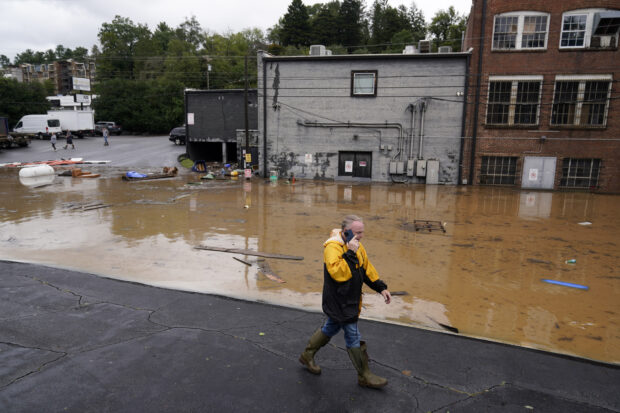Back-to-back hurricane landfalls in the span of less than two weeks have placed flood insurance in a new light for many inside and outside of the insurance industry, if not front and center.
Images of flood and storm damage from North Carolina and Florida can be a startling reminder that a standard homeowners insurance policy or even commercial property insurance coverage may not provide a quick path to financial recovery from torrential, life-threatening flooding.
This type of coverage has traditionally been available through the National Flood Insurance Program (NFIP), which began in 1968 as a way to protect property owners against flood damage. The government program was financially sustainable, up until Hurricane Katrina in 2005. Since then, tropical systems and the likes of Hurricane Sandy have saddled the NFIP with large chunks of debt.
Despite Congress cancelling $16 billion of the program’s debt in 2018, the NFIP was $20.5 billion in the red ahead of this year’s hurricane season. This will be exacerbated by the active 2024 hurricane season.
The NFIP implemented Risk Rating 2.0 as a way to recalibrate and correct the program’s pricing shortfalls, taking into account the actual level of flood risk for each property and attempting to determine an adequate risk charge for each specific property. The goal was to have the rates reflect the most up-to-date information about distance to the closest flood source, the risk of rainfall related flooding, and the actual cost of replacing or rebuilding.
The new pricing plan went into effect for new policies in October 2022 and for renewals in April 2023. While the NFIP policy count has declined since 2019, that drop-off has accelerated in the past two years, partly attributable to affordability issues about the price of federal flood coverage under the new rating plan. Despite capping increases on renewals policies at 18 percent annually, the initial pricing increases have been too much for some policyholders to bear.
A movement by policyholders to private flood insurance was noticeable, along with an increased interest by some insurers in writing their own private flood coverage. There was a big bump initially in 2022 as the private market wrote $1.3 billion of the flood market’s direct premiums written (most of which is on commercial property), which was up by 24.6 percent from 2021.
The level written by the private sector remained relatively flat at $1.4 billion for 2023. Just where that level goes in 2024 remains to be seen because of the impact from continued increases in NFIP policy pricing. NFIP premiums under Risk Rating 2.0 could take up to five years to reach actuarially sound rates for all insureds. Any competitive impact of pricing will likewise take as long for the full effect to make its way into the market. This would also depend significantly on the flood risk appetite of the private insurance market.
Hurricanes have become the biggest cause of large flood losses, and Florida has become the largest overall market for flood insurance in the United States, with over 30 percent of total flood premium, more than double that of any other state. However, in Florida and other states prone to hurricanes, the share of flood insurance purchased in the private market is lower than the national average.
First-half results (primarily before Atlantic hurricane season, which commences on June 1 and ends on Nov. 30), have traditionally indicated that the NFIP would be able to cover the type of flooding contemplated at the program’s origin. However, major floods in California and Florida occurred in the first half of 2023, with each causing over $1 billion in damages. The federal flood loss ratio in the first half of 2023 was over 70.0 but remained below 50.0 in 2022 and 2024 (which were relatively benign catastrophe years). This highlights the event-driven nature of flood losses. The second half of 2024 will be more telling and likely challenge profitability overall and pressure capital resources, including NFIP’s available capital, reinsurance, capital market placements, and its borrowing authority.
The spending resolution approved by Congress in late September of this year will extend the NFIP through Dec. 20, 2024. Given the program’s debt, with every budget negotiation, it will likely be subject to debate again as the resolution approaches its end. However, without the NFIP, there would be a large void in the flood insurance market, which private flood insurers do not appear eager to completely fill at this point.
Even with the recent federal re-authorization of a short-term extension for the NFIP, it is becoming clear that absent any long-term solution to stabilize the federal program, the debt level will only climb higher. A more viable role for private flood insurers is also challenging in the absence of a clear, long-term solution for NFIP and increasing climate risk.
Photograph: A man walks near a flooded area near the Swannanoa river, effects from Hurricane Helene , Friday, Sept. 27, 2024, in Asheville, N.C. (AP Photo/Erik Verduzco, File)





















 Berkshire Hathaway Announces Leadership Appointments: New CEO at GEICO
Berkshire Hathaway Announces Leadership Appointments: New CEO at GEICO  A Practical Blueprint: The Five Plays of an Innovation Culture
A Practical Blueprint: The Five Plays of an Innovation Culture  Women Are Now Leaning Out in the Workplace
Women Are Now Leaning Out in the Workplace  The Latest Launches from Allstate, WTW, Whisker Labs
The Latest Launches from Allstate, WTW, Whisker Labs 





